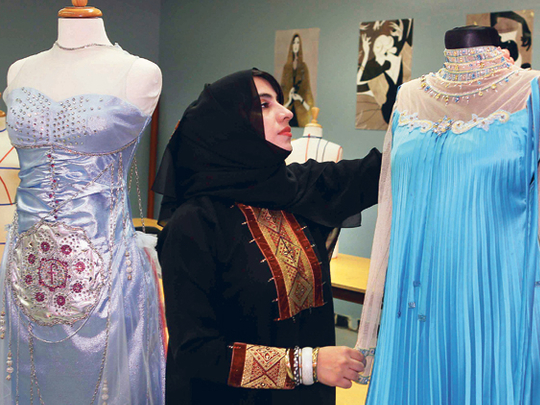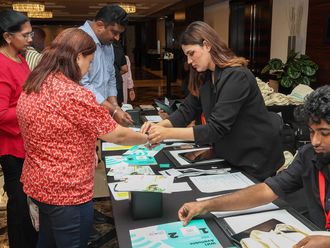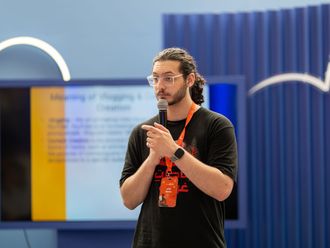
Increased global interest in Islamic fashion offers students an opportunity to tap a growing market worth more than $96 billion (Dh350 billion) say heads of UAE-based fashion universities.
Tamara Hostal, Director of French Fashion University ESMOD Dubai (ESMOD), said this figure comprises 50 per cent of the world's 1.6 billion Muslims, each spending at least $120 (Dh438) a year on modest clothing.
"Fashion today is moving and passing between different continents as more people travel the world and bring traditional influences back to their own countries," she said. "People are increasingly showing they want to wear clothes influenced by Islamic culture as countries that are not yet very Islamic are starting to be," she added.
Ajman student wins Miami fashion week competition
Hostal used the example of global brands like Fendi, Gucci and Calvin Klein introducing Islamic elements into their recent collections, making it apparent that growing trends and increased demand in a fashion-conscious world means Muslims are no exception.
Catering to demand
"We shouldn't only focus on Muslims," said Saqib Suhail. "There are conservative Christians as well as Jews all over the world and we can cater to all these people," said Suhail, head of the fashion department at Preston University Ajman (PUA).
"We can see Arabic styles steadily influencing European street fashion, which proves the potential of this emerging niche," said Hostal.
One example is the keffiyeh, which exploded internationally nearly two years ago as a fashion necessity. "Lots of celebrities adorn Islamic clothing," said Suhail.
"Take the keffiyeh, Kanye West started wearing it, not for the Palestinian cause but for the fashion element, and then designers started implementing it into their collections."
Vanessa Northway, academic head of the school of textiles and design at Heriot-Watt University Dubai Campus (HW), says international fashion houses are developing from Arabic and Islamic themes within their collections as demand grows from fashion-conscious consumers in the Middle East and beyond.
"[Consumers] want to wear fashion that is both cutting-edge and reflects their own artistic and cultural aspirations," she said.
Yet to students, Islamic fashion is not about money but more about spreading a message and marking their identity. "As an Arab and Muslim woman I am affected by my culture and religion and I want to spread it to the world," said Samah Ali, a Palestinian fashion student at PUA. "I want to show the world my message and the beauty in my heritage,' she added.
Getting creative
"We are beginning to see teenage Muslim girls wearing western clothing in a layered manner to stay modest yet keep up with fashion trends," said Suhail. He believes Islamic fashion does not have to be limited to the traditional attire of the region. "We have introduced workshops for making skirts, jackets, hijabs and business suits for Muslim women so they can be trendy and wear Islamic fashion," he added.
Western fashion emphasises body-fitting garments whereas Islamic fashion emphasises loose-fitting fabrics, embroidery and colours, explained Suhail. "Modesty is not that hard to achieve, you just have to redraw the proportions of the body so cuts are not hour glass but mostly A-line," he said.
However, it is a new generation of fashion designers in the Middle East and South East Asia who seek to fuse modernity with Eastern styles.
"Traditional clothing is part of our heritage and I want to bring it out in a modern way so people can wear it," said Ali. "In my designs I want to conserve our heritage but make it appealing to the rest of the world," she added.
Untapped market
"Fashion is about discovering with style and Islam is about being modest," said Aqsa Aslam, a fashion student at PUA.
"In contemporary abayas it's not about the stitching of the garment but more the Islamic print and Arabic calligraphy,' she added.
Students at HW are taught modules in which they explore elements of Arabic and Islamic culture in their designs. "A recent month-long project we developed was themed around Bedouin lifestyle and architecture," said Northway. In this students had to design a contemporary end product at the end of it.
Similarly, at PUA, students are taught to consider Eastern fashion elements. "As part of the curriculum we teach students how to design and stitch jalabiyas, abayas, shaylas, kandouras and kaftans," said Suhail. "We want to make students realise there is a huge market in such designs. These things are in demand and they sell, so students should know how to make them," he added.
Bringing the UAE back into fashion
An emerging Emirati talent competition winner will showcase her modern Emirati fashion designs at Dubai Fashion Week next month. Mouza Al Mazroui, a young fashion designer, will showcase her designs at the upcoming Dubai Fashion Week (DFW) as one of four winners of the Splash emerging talent contest.
The contest is a platform which springboards young talent to success as it did for fashionista Rabia Z. who won it in 2007, and is now renowned for her modest clothing line.
As one of the winners she gets to showcase 10 pieces on April 6 during DFW. Yet, Mouza, a recent French Fashion University ESMOD Dubai graduate, is biting her fingernails as she awaits the final stitching of her creations.
"I'm so excited but nervous about delivering on time," she said. "I'm working with several tailors but when you do it yourself you feel more in control," she added.
Mouza describes her style as "very modern with an Emirati twist", as she spotted a niche in the market for ready-to-wear Arabic designs with an international look.
"The Emirati wardrobe is very vibrant and rich with colours and I want to bring it back into fashion," she said. "Few know about the traditional Emirati wardrobe unless you're an Emirati and you've seen your mother wearing it," added Mouza.












